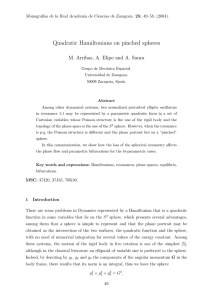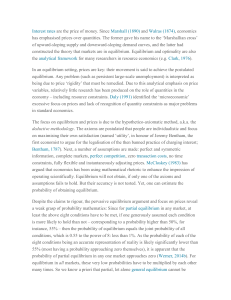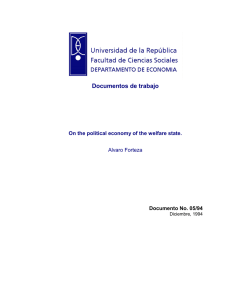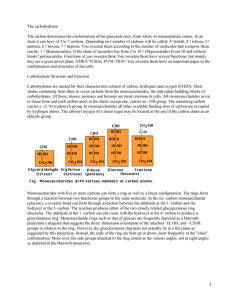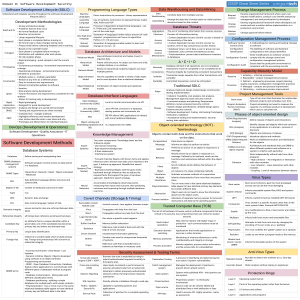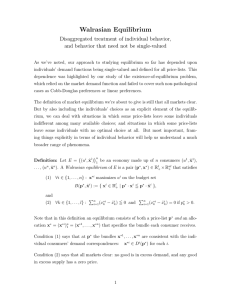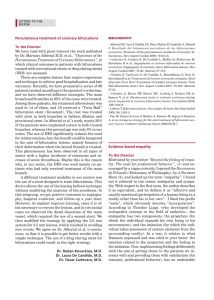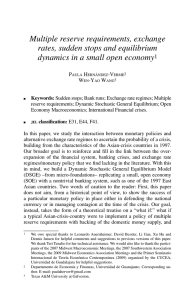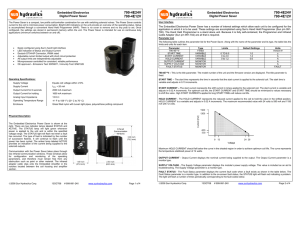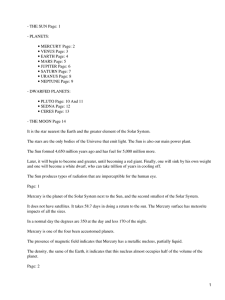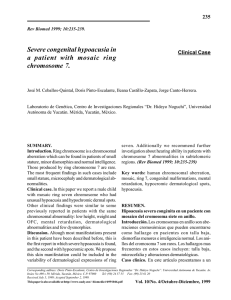n + 2 - Universidad de Zaragoza
Anuncio
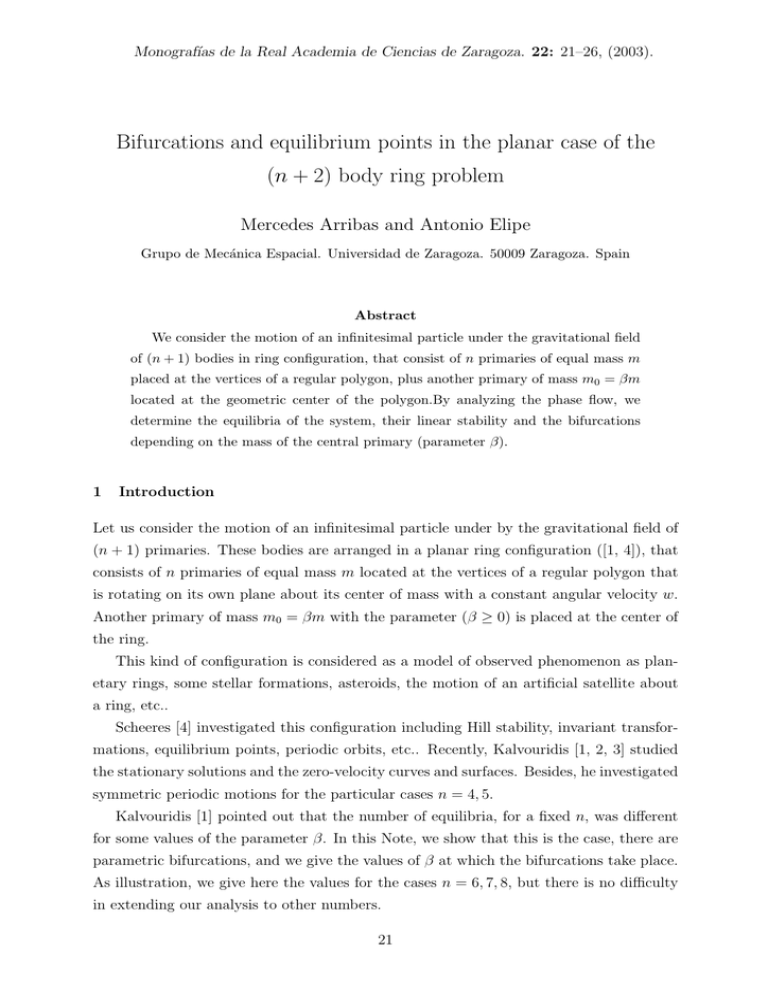
Monografı́as de la Real Academia de Ciencias de Zaragoza. 22: 21–26, (2003). Bifurcations and equilibrium points in the planar case of the (n + 2) body ring problem Mercedes Arribas and Antonio Elipe Grupo de Mecánica Espacial. Universidad de Zaragoza. 50009 Zaragoza. Spain Abstract We consider the motion of an infinitesimal particle under the gravitational field of (n + 1) bodies in ring configuration, that consist of n primaries of equal mass m placed at the vertices of a regular polygon, plus another primary of mass m0 = βm located at the geometric center of the polygon.By analyzing the phase flow, we determine the equilibria of the system, their linear stability and the bifurcations depending on the mass of the central primary (parameter β). 1 Introduction Let us consider the motion of an infinitesimal particle under by the gravitational field of (n + 1) primaries. These bodies are arranged in a planar ring configuration ([1, 4]), that consists of n primaries of equal mass m located at the vertices of a regular polygon that is rotating on its own plane about its center of mass with a constant angular velocity w. Another primary of mass m0 = βm with the parameter (β ≥ 0) is placed at the center of the ring. This kind of configuration is considered as a model of observed phenomenon as planetary rings, some stellar formations, asteroids, the motion of an artificial satellite about a ring, etc.. Scheeres [4] investigated this configuration including Hill stability, invariant transformations, equilibrium points, periodic orbits, etc.. Recently, Kalvouridis [1, 2, 3] studied the stationary solutions and the zero-velocity curves and surfaces. Besides, he investigated symmetric periodic motions for the particular cases n = 4, 5. Kalvouridis [1] pointed out that the number of equilibria, for a fixed n, was different for some values of the parameter β. In this Note, we show that this is the case, there are parametric bifurcations, and we give the values of β at which the bifurcations take place. As illustration, we give here the values for the cases n = 6, 7, 8, but there is no difficulty in extending our analysis to other numbers. 21 2 Equations of motion To describe the motion of the infinitesimal particle we choose a planar reference frame that is rotating at an angular velocity w; the origin coincides with the centre of masses of the central body; the x-axis coincides with the line joining the central body with one of the primaries on the ring. With a suitable choice of units of time and length, the equations of motion in this synodic frame can be expressed as (see [1] for details) ẍ − 2ẏ = − ∂U , ∂x ÿ + 2ẋ = − ∂U , ∂y where the effective potential is 1 1 U (x, y) = − (x2 + y 2 ) − 2 ∆ n β 1 + ; r0 i=1 ri (1) r0 is the distance of the particle to the central body; ri the distance to the mass mi , given by r0 = x2 + y 2 , ri = (x − xi )2 + (y − yi )2 , i = 1, . . . , n with (xi , yi ) the coordinates of the peripheral i-th body: cos 2π(i − 1)/n xi = , 2(1 − cos 2π/n) sin 2π(i − 1)/n yi = , 2(1 − cos 2π/n) and ∆ = M (Λ + βM 2 ) is a constant depending on the parameter β and the number n of primaries though the relations M= (2(1 − cos2θ)), Λ= n i=2 3 sin2 θ cos(n/2 + 1 − i)θ sin2 (n + 1 − i)θ and θ = π . n Equilibrium solutions and their stability As is well known, the equilibrium points are obtained by solving the algebraic system ∂U = 0, ∂x ∂U =0 ∂y and their linear stability depends on the roots of the characteristic equation: 2 )=0 λ4 + (4 + Uxx + Uyy )λ2 + (Uxx Uyy − Uxy Due to the complexity of the expressions involved in the partial derivatives, we do not try to obtain the solution analytically; rather, we proceed numerically for some specific values of n and see the evolution of the equilibria in terms of the parameter β. But prior to find the equilibria, and in order to have some information about the problem we are 22 1 0 -2 2 -1 0 -1 1 2 -2 2 -3.5 1 -4 0 -4.5 -1 -5 -2 -2 -1 0 1 2 Figure 1: The effective potential and contour level curves for n = 6 and β = 0.0 dealing with, we made some plots of the effective potential (1) for several values of n and β. Some of the surfaces and contour plots appear in Figures 1,2 and 3. In these graphics we can observe a lot of symmetries. Indeed, it is easy to see that the potential is invariant by rotations of angle 2π/n, thus, we limit our study to the angular sector 0 ≤ ψ < 2π/n, and in this sector, it is not difficult to prove that the equilibria are located along two lines passing through the origin, namely 1. The x+ axis. 2. The bisector between two primaries. Just to avoid loss of digits in the numerical calculation, the latter will be chosen as 2. a) x− axis, if n is odd. 2. b) y + axis, if n is even and not multiple of 4 . 2. c) Bisector (x = r cos π/n, y = r sin π/n), otherwise. By doing so, we have determined the equilibria for different values of n and β, and analyzed their stability. We have chosen a sample for each case, i. e., we have consider the values for n = 6, 7, 8. In Figure 4 we can observe the evolution in the position of the equilibrium points for n = 6. On the left hand the evolution with respect to the parameter β of the two equilibrium points located on the x+ axis. When β increases the points approaches to 23 0 -1 -2 -4 1 -2 2 -1 0 1 2 2 1 -4.5 0 -5 -1 -5.5 -2 -2 -1 0 1 2 Figure 2: The effective potential and contour level curves for n = 7 and β = 0.8 the external primary on the ring. The two equilibria are unstable. On the right hand of the same figure, we present the evolution of the three unstable critical points located along the bisector (in this case the y + axis). However, at β = 1.6049060055, two of them disappear and only one remains, namely, the one placed outside the ring. We have, thus, found a bifurcation. The situation for n = 7 and n = 8 is analogous. We find two equilibria along the x+ axis and both are unstable. When we seek for equilibrium solutions along the bisector (x− for n = 7 and the bisector for n = 8), and different values of the parameter β, starting in β = 0 we find three points that are unstable, but at a certain value of the parameter, two of them coalesce and disappear. The bifurcations take place at β = 3.0951324748 for n = 7, and at β = 5.26863687811 for n = 8. In Figures 5 and 6 we represent the location of these points with respect to the parameter β. Acknowledgments Partially supported by the Ministerio de Ciencia y Tecnologı́a (Projects #PB98-1576 and #ESP2000-023929). References [1] T.J. Kalvouridis, Astrophysics and Space Science 260, 309-325 (1999). [2] T.J. Kalvouridis, Celestial Mechanics and Dynamical Astronomy 80, 133-144 (2001). 24 -2 2 1 -1 0 1 0 2 -1 -2 2 -4 1 -4.5 0 -5 -1 -2 -2 -1 -5.5 0 1 2 Figure 3: The effective potential and contour level curves for n = 8 and β = 5.8 r r 1.75 1.5 1.5 1.25 1.25 1 1 0.75 0.75 0.5 0.5 0.25 0.25 β β 2 4 6 8 10 1 2 3 4 Figure 4: Case n = 6. Position of the equilibria versus β. Left, points on the x-axis; right, points on the bisector. There is a bifurcation at β = 1.6049060055. [3] T.J. Kalvouridis, Astrophysics and Space Science 266, 467-494 (1999). [4] D.J. Scheeres, On symmetric central configurations with application to satellite motion about rings. Ph. D. Thesis, University of Michigan. (1992). 25 r r β 2 1.5 4 6 8 -0.25 -0.5 1 -0.75 -1 0.5 -1.25 β 5 10 15 -1.5 20 -1.75 Figure 5: Case n = 7. Position of the equilibria versus β. Left, points on the x-axis; right, points on the bisector (y − -axis). There is a bifurcation at β = 3.0951324748. r r 2 2 1.5 1.5 1 1 0.5 0.5 β 2 4 6 8 β 2 10 4 6 8 10 Figure 6: Case n = 8. Position of the equilibria versus β. Left, points on the x-axis; right, points on the bisector. There is a bifurcation at β = 5.26863687811. 26
